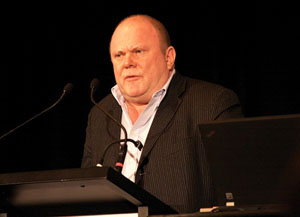NBN time frame, budget doable: Kordia

Progress to date indicates that the NBN can be built on time and on budget, a key architect of the Townsville first release roll-out has said, as long as a collective and proactive effort ensures an ample supply of suitable skills when and where they're needed.

Peter Robson (Credit: David Braue/ZDNet Australia)
"The roll-out is over an eight-year period, which makes it doable," Kordia Solutions managing director Peter Robson told the audience at the CommsDay Melbourne Congress, where a who's-who of Australia's telecommunications industry this week gathered to discuss the NBN and related issues. Kordia, in a joint bid with with Downer EDI, was chosen by NBN Co to design an NBN first-release roll-out spanning 3100 premises in the Townsville suburbs of Aitkenvale and Mundingburra. Construction on the roll-out began in August.
"The technology is proven, but to date only 3000 brownfield homes [existing premises] around the country have been connected to fibre," Robson said. "It's a long way from 3000 to 10 million [nationwide], and that gives an idea of the scale of the challenges that we face."
Skills were a major issue for the roll-out, with the Kordia-Downer partnership currently able to access around 500 employees and 1000 subcontractors. Yet with the NBN expected to create up to 20,000 full-time equivalent jobs, Robson said Australia's talent pool is still far too shallow. For example, many contractors lack the specialised training necessary to safely work in and around power cables both on aerial poles and in underground ducts.
"We think the subcontractor base lacks depth and doesn't necessarily have the same capability to ramp up as the larger contractors do," Robson said. "The lead time on some of that training can be three to four years, and that needs to be built into preparation for the roll-out, as does planning for access to equipment such as directional drilling equipment that can have lead times of six to nine months.
"Forward planning and project management skills are going to be critical; the sort of people you need are going to be information-rich constructors."
Aiming to bolster the companies' credentials in bidding for further NBN work, Robson took the occasion to announce that Kordia and Downer EDI would expand their partnership to include infrastructure contractor Tenix, which has the sort of skills Robson says are in short supply. Kordia will also bolster its design capability with international partnerships and a focus on getting designers into the field to reflect the challenges of wiring existing premises.
Whereas the approximately 1 million greenfield NBN roll-outs (those into new developments or houses) could be planned from the ground up, brownfield deployments need to be handled differently to account for real-world variations.
"That's something that can't be done from behind a desk," Robson explained. "You've got to know what the infrastructure is actually like, to balance up the various options to get the best result. It requires a slightly different skill set to what's available generally, with different tools and systems."
Other practical issues requiring attention range from community engagement and diversified project management expertise to the need for a dynamic database to track exactly which properties have been connected to the NBN and to make sure that new premises are added to the database as they're built.
Yet Robson is confident the NBN roll-out can proceed apace. "Despite all these challenges, we believe the NBN can be built on time and on budget; that the time frame is appropriate; and that the technology is proven. There will be a huge effort involved, particularly in getting the skills base up to scratch but from what we're seeing, it looks like it can be done."